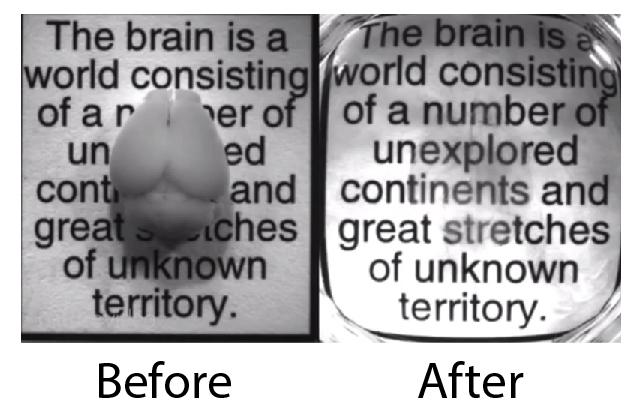AUTHOR: Justin Balsor

Turning brains invisible clearly has its advantages. Find out how a transparent brain caught my eye, what makes them possible, and why they may be the right method for you to use!
In the first MiNDS colloquium of 2015, Dr. Sheena Josselyn gave an excellent talk about her work linking CREB-expressing neurons with memory formation. At the end of her talk, Dr. Josselyn talked about an exciting new technique that she has used in her lab to turn a mouse brain transparent. Josselyn was quick to credit Dr. Karl Deisseroth as the creator of this amazing technique, called CLARITY. In a powerful display of CLARITY, as well as an homage to its creator, Josselyn presented a slide with two photos of Deisseroth placed side by side. In the first photo, part of Karl’s face was obstructed by a mouse brain, while the second photo showed the same picture of Karl, but without obstruction. Dr. Josselyn told the audience that both photos have the same mouse brain in front of Karl’sphoto, with the difference being that the first photo was taken before the mouse brain was rendered completely transparent by the CLARITY technique. This was an extremely powerful way to present a very hot topic in the realm of neuroscience techniques.
While invisible brains seem like something out of a science fiction movie, clearing organs is not exactly something new to the health sciences. A challenge faced by many neuroscientists is that structures located below the surface lie just out of reach of most microscopy techniques, and researchers have to resort to slicing the brain in order to understand these subcortical neuronal networks. Then, after these slices are analyzed, they must be re-aligned, and re-assembled into a three-dimensional structure, which is a very difficult and time-consuming task. A transparent brain, on the other hand, is so tantalizing because it maintains three-dimensional neuronal networks and allows subcortical areas to be studied in the intact organ.
While invisible brains seem like something out of a science fiction movie, clearing organs is not exactly something new to the health sciences. A challenge faced by many neuroscientists is that structures located below the surface lie just out of reach of most microscopy techniques, and researchers have to resort to slicing the brain in order to understand these subcortical neuronal networks. Then, after these slices are analyzed, they must be re-aligned, and re-assembled into a three-dimensional structure, which is a very difficult and time-consuming task. A transparent brain, on the other hand, is so tantalizing because it maintains three-dimensional neuronal networks and allows subcortical areas to be studied in the intact organ.